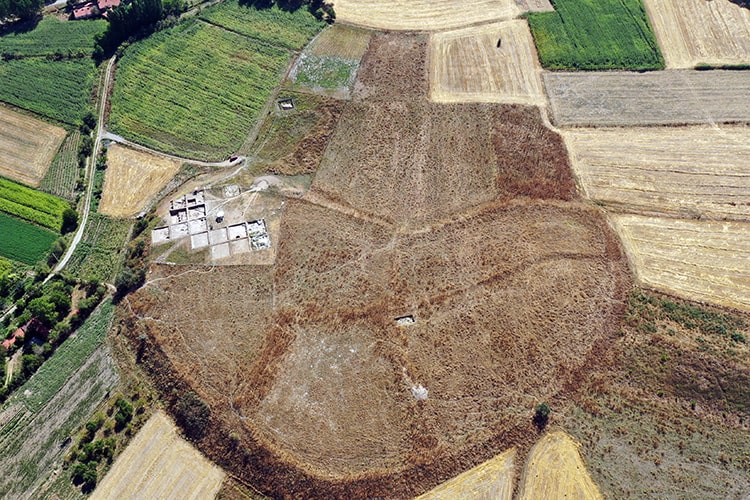
The tombstones in the Seljuk Cemetery in Konya are being restored
The historical tombstones in the Musalla Cemetery, one of the prominent Seljuk cemeteries in Konya, which served as the capital of the Anatolian Seljuks, are being restored. Musalla Cemetery is located in the central district of Selçuklu in Konya. Recently, new burial areas are not being permitted. The restoration of the historical tombstones in Musalla

Archaeological excavations have begun in the ancient city of Shuayb, also known as the “Ephesus of the Southeast.”
Archaeological excavations have begun in the ancient city of Shuayb, known as the “Ephesus of the Southeast,” with architecture reminiscent of the renowned city of Ephesus from the Ancient Age in Anatolia. The ancient city of Shuayb is located near the village of Özkent, 80 km away from the Harran district of Şanlıurfa. The city

Ritual dog graves associated with the goddess Gula have been uncovered at the Harran archaeological site
In the Harran archaeological site, one of the oldest settlements in the world located in southeastern Türkiye, four dog graves dating back to the Iron Age have been uncovered. The ritualistically buried dogs are interpreted as a sign of belief in the healing goddess Gula. The Harran archaeological site, which is on the UNESCO World

In a 6th-century Anglo-Saxon tomb, an ancient Roman chalice was discovered containing pig fat
In 2018, archaeologists conducting excavations in Scremby, Lincolnshire, uncovered an enameled copper alloy chalice within a 6th-century AD female grave. This discovery was part of a study by the University of Sheffield, focusing on a Migration Period cemetery in Scremby that features 49 burials dating from 480 to 540 AD. The multicolored goblet, approximately 1,800

Prof. Ian Hodder, “I believe that Göbekli Tepe changes the story about the origins of human society.”
British archaeologist Prof. Ian Hodder stated, “I believe that Göbekli Tepe changes the story about the origins of human society.” Prof. Hodder directed excavations at Çatalhöyük, the first Neolithic settlement in Anatolia, for 25 years. Ian Hodder, who participated in the Wildlife Photographer of the Year exhibition organized by the Natural History Museum (NHM) at

The heart of Kütahya, at Tavşanlı Mound, has yielded a 3,200-year-old piercing tool and tweezers made of bronze
Due to its heart-shaped appearance when viewed from above, Tavşanlı Mound, referred to as the heart of Kütahya, has yielded a 3,200-year-old bronze piercing tool with a bone handle and tweezers during excavations. Tavşanlı Mound is located approximately 1.5 kilometers from the center of Kütahya and is one of the largest mounds in Anatolia, with

Archaeologists discovered a 500-year-old Chinese inscription on Mount Zion in Jerusalem
Archaeologists have discovered a 500-year-old Chinese inscription on a piece of blue-and-white porcelain found on Mount Zion, representing the oldest known Chinese writing found in Israel. The inscription states, “Forever we will protect the eternal spring,” and was uncovered during a three-year collaborative excavation conducted by the Israeli Antiquities Authority (IAA) and the German Protestant

A tabula ansata featuring a bilingual inscription, found in front of a burial chamber adorned with the monogram of Jesus Christ, was restored
A bilingual inscription tabula ansata located in front of a burial chamber adorned with the monogram of Jesus Christ, found in the Kızılkoyun necropolis in Şanlıurfa, has been restored and returned to its original position. Kızılkoyun Necropolis is located in the Balıklıgöl plateau of Şanlıurfa. It bears traces of Hellenistic and Roman-Byzantine periods with tombs

The settlement at Asarcık Tepe, which dates back to the Hittites, has structures from the Seljuk period
The excavations at Asarcık Tepe, which bears traces of a culture dating back to the 3rd millennium BC, revealed dwelling and bakery structures dating back to the Seljuk period. Asarcık Tepe is especially important as a Hittite settlement and therefore it is one of the rare settlements in the region. Asarcık Tepe is located in

The inscription dedicated to Emperor Hadrian was found in Blaundos, known as Garrison City
An inscription dedicated to Emperor Hadrian has been found in the ancient city of Blaundos, which was named “Garrison City” because Alexander the Great’s soldiers settled there during his campaign in Anatolia. Hadrian, known as one of the emperors of the Roman Empire who loved to travel, ruled from 117 to 138 AD. Born in
